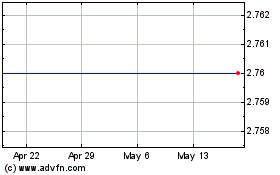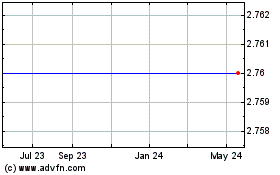Stock Market News for June 8, 2011 - Market News
June 08 2011 - 5:07AM
Zacks
On Tuesday, Ben Bernanke said US economic growth remained
“frustratingly slow from the perspective of millions of unemployed
and underemployed workers”. Such comments from the Federal Reserve
Chairman kept the investors bearish as the markets suffered losses
for the fifth consecutive trading day. Markets had been moving up
initially but Bernanke’s comments ensured benchmarks extended their
stay in the red, yet again.
The markets have now declined
for five consecutive trading day and the Dow Jones Industrial
Average (DJIA) lost 0.2% to settle at 12,070.81. After dropping
below the psychological level of 1,300 for the first time since
March 23, 2011, on Monday, the Standard & Poor 500 (S&P500)
continued to be weighed down as it declined again, by 0.1%, to
close at 1,284.94. The Nasdaq Composite Index was down less than
0.1% to finish off at 2,701.56. On the New York Stock Exchange,
declining stocks outnumbered the stocks that climbed higher by a
ratio of 1,684 to 1,297. Consolidated volumes on the NYSE were 3.6
billion shares.
Global pressures and domestic
disappointing data indicating slowing economic growth have dampened
investor sentiment for quite some time now. Discouraging data about
job markets, the housing sector, manufacturing output, higher
gasoline prices and the lack of any catalyst have resulted in
markets taking losses for five consecutive weeks. For the week, the
indices are lingering in the red and if the trend continues the
markets will surely be recording a six week losing streak, which
will highlight huge concerns about the economy. Amidst such a
trough trajectory, Bernanke disappointed many who believed the Fed
will be declaring another round of economic stimulus.
Ben Bernanke acknowledged the
slowdown in economic progress as he delivered his speech at the
International Monetary Conference in Atlanta. While the markets had
opened with gains, moments after Bernanke started his speech
benchmarks started to move lower. Bernanke said: “U.S. economic
growth so far this year looks to have been somewhat slower than
expected. Aggregate output increased at only 1.8% at an annual rate
in the first quarter, and supply chain disruptions associated with
the earthquake and tsunami in Japan are hampering economic activity
this quarter. A number of indicators also suggest some loss of
momentum in the labor market in recent week”.
Bernanke also targeted
critics who had blamed the Fed policy for the surging prices. He
mentioned the supply and demand dynamic was the reason behind price
rise and said: “When the price of any product moves sharply, the
economist’s first instinct is to look for changes in the supply of
or demand for that product…Indeed, the recent increase in commodity
prices appears largely to be the result of the same factors that
drove commodity prices higher throughout much of the past decade:
strong gains in global demand that have not been met with
commensurate increases in supply. With the demand for oil rising
rapidly and the supply of crude stagnant, increases in oil prices
are hardly a puzzle”.
The job market has posed a
threat to the recovery and employment reports have suggested no
improvement in the economy. Bernanke mentioned that an improving
job market is vital for “setting the course for household
spending”. Further, he opined: “As you know, the jobs situation
remains far from normal,” and added “Until we see a sustained
period of stronger job creation, we cannot consider the recovery to
be truly established”.
Additionally, Bernanke said:
“Although it is moving in the right direction, the economy is still
producing at levels well below its potential; consequently,
accommodative monetary policies are still needed.” Nonetheless, he
did not suggest any possibility of the third round of quantitative
easing. The current $600 billion bond purchase program is scheduled
to stop this month end. This worked against many investors who had
been hoping for an economic stimulus plan.
However, Bernanke is hopeful
of a better performance in the second half of the year and said he
expected a better hiring scenario “from last month’s pace as growth
strengthens in the second half of the year”. He further assured
prospects of lower gasoline prices and said the sluggish outlook
for the April-June period, which was mainly due to the effects of
the Japanese natural disaster, will dissolve in the upcoming
months. He assured: “growth seems likely to pick up somewhat in the
second half of the year”.
As the benchmarks struggled
to cope up with a disappointing employment situation, the Labor
Department reported job openings in the US had declined for the
first time in three months. According to the department, the number
of positions that are to be filled declined by 151,000 to 2.97
million. The report also reflected the lack of faith among the
companies about the recovery.
Among stocks in focus were,
Temple-Inland Inc. (NYSE:TIN), International Paper Co. (NYSE:IP),
Ford Motor Company (NYSE:F) and Sunoco, Inc. (NYSE:SUN) and they
surged 40.4%, 0.4%, 0.3% and 4.0%, respectively. One of the leading
decliners for the day was The Talbots, Inc. (NYSE:TLB), which dived
40.5% after its quarterly results failed to beat
estimates.
The financial stocks shared
the losses as the Financial Select Sector SPDR fund was down 0.2%.
Among decliners in the sector were Citigroup Inc. (NYSE:C), The
Goldman Sachs Group, Inc. (NYSE:GS), Bank of America Corporation
(NYSE:BAC) and Wells Fargo & Company (NYSE:WFC) and they
dropped 1.3%, 0.7%, 1.7% and 1.9%, respectively.
BANK OF AMER CP (BAC): Free Stock Analysis Report
CITIGROUP INC (C): Free Stock Analysis Report
FORD MOTOR CO (F): Free Stock Analysis Report
GOLDMAN SACHS (GS): Free Stock Analysis Report
INTL PAPER (IP): Free Stock Analysis Report
SUNOCO INC (SUN): Free Stock Analysis Report
TEMPLE-INLAND (TIN): Free Stock Analysis Report
TALBOTS INC (TLB): Free Stock Analysis Report
WELLS FARGO-NEW (WFC): Free Stock Analysis Report
Zacks Investment Research
Talbots (NYSE:TLB)
Historical Stock Chart
From Jun 2024 to Jul 2024

Talbots (NYSE:TLB)
Historical Stock Chart
From Jul 2023 to Jul 2024
